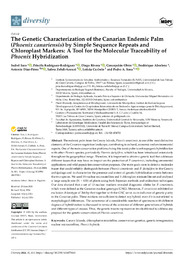Título :
The Genetic Characterization of the Canarian Endemic Palm (Phoenix canariensis) by Simple Sequence Repeats and Chloroplast Markers: A Tool for the Molecular Traceability of Phoenix Hybridization |
Autor :
Saro, Isabel
Rodríguez Rodríguez, Priscila
Rivera, Diego
Obon, Concepcion 
Aberlenc, Fredérique
Díaz Pérez, Antonio
Zehdi Azouzi, Salwa
Curbelo, Leticia
Sosa, Pedro A. |
Editor :
MDPI |
Departamento:
Departamentos de la UMH::Biología Aplicada |
Fecha de publicación:
2024-07 |
URI :
https://hdl.handle.net/11000/38294 |
Resumen :
The endemic palm from the Canary Islands, Phoenix canariensis, is one of the most distinctive
elements of the Canarian vegetation landscape, contributing to cultural, economic and environmental
aspects. One of the main conservation problems facing this iconic palm is anthropogenic hybridization
with other Phoenix species, particularly Phoenix dactylifera, which has been introduced extensively
throughout its geographical range. Therefore, it is important to obtain a genetic tool that addresses
different issues that may have an impact on the protection of P. canariensis, including ornamental
applications and wild population conservation purposes. Our main goals were to detect a molecular
tracer that could reliably distinguish between Phoenix canariensis and P. dactylifera in the Canary
archipelago and to characterize the presence and extent of genetic hybridization events between
the two species. We used 19 nuclear microsatellites and 1 chloroplast minisatellite set and analysed
a large sample size (N = 433) of plants using both Bayesian methods and ordination techniques.
Our data showed that a set of 13 nuclear markers revealed diagnostic alleles for P. canariensis,
which were defined as the Canarian nuclear genotype (CNG). Moreover, P. canariensis exhibited an
exclusive chlorotype of 266 bp that together with the GNC serve as an indicator of genetic purity
in the Canarian palm. These markers are sufficient to detect any hybrid, even if it is not related to
morphological differences. The occurrence of a considerable number of specimens with different
degrees of hybridization is discussed in terms of the existence of different generations of hybrids
and different types of crosses. Thus, the genetic tracers represent an invaluable tool to address any
proposal for the genetic conservation of Phoenix canariensis.
|
Palabras clave/Materias:
Canary Islands
chloroplast minisatellite
conservation genetics
genetic introgression
nuclear microsatellites
Phoenix hybrids |
Tipo de documento :
info:eu-repo/semantics/article |
Derechos de acceso:
info:eu-repo/semantics/openAccess
Attribution-NonCommercial-NoDerivatives 4.0 Internacional |
DOI :
https://doi.org/10.3390/d16070411 |
Publicado en:
Diversity 2024, 16, 411. |
Aparece en las colecciones:
Artículos - Biología Aplicada
|
 La licencia se describe como: Atribución-NonComercial-NoDerivada 4.0 Internacional.
La licencia se describe como: Atribución-NonComercial-NoDerivada 4.0 Internacional.
.png)
